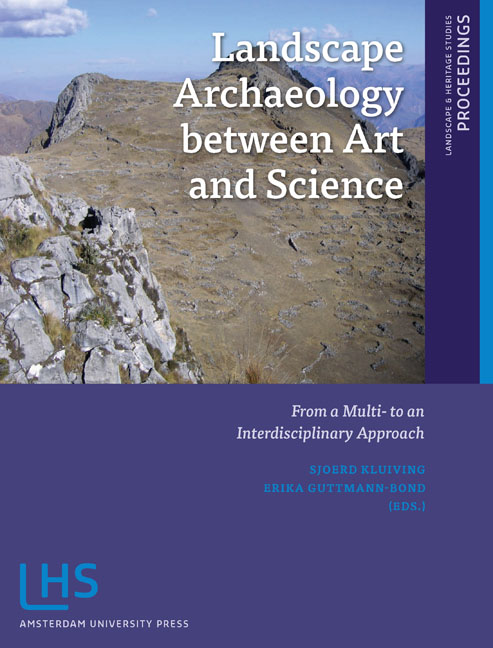Book contents
- Frontmatter
- Contents
- Preface
- Introduction: LAC2010: First International Landscape Archaeology Conference
- THEME 1 HOW DID LANDSCAPE CHANGE?
- THEME II IMPROVING TEMPORAL, CHRONOLOGICAL AND TRANSFORMATIONAL FRAMEWORKS
- THEME III LINKING LANDSCAPES OF LOWLANDS TO MOUNTAINOUS AREAS
- THEME IV APPLYING CONCEPTS OF SCALE
- THEME V NEW DIRECTIONS IN DIGITAL PROSPECTION AND MODELLING TECHNIQUES
- THEME VI HOW WILL LANDSCAPE ARCHAEOLOGY DEVELOP IN THE FUTURE?
- Miscellaneous Endmatter
2.5 - The Medieval Territory of Brussels: A Dynamic Landscape of Urbanisation
Published online by Cambridge University Press: 21 January 2021
- Frontmatter
- Contents
- Preface
- Introduction: LAC2010: First International Landscape Archaeology Conference
- THEME 1 HOW DID LANDSCAPE CHANGE?
- THEME II IMPROVING TEMPORAL, CHRONOLOGICAL AND TRANSFORMATIONAL FRAMEWORKS
- THEME III LINKING LANDSCAPES OF LOWLANDS TO MOUNTAINOUS AREAS
- THEME IV APPLYING CONCEPTS OF SCALE
- THEME V NEW DIRECTIONS IN DIGITAL PROSPECTION AND MODELLING TECHNIQUES
- THEME VI HOW WILL LANDSCAPE ARCHAEOLOGY DEVELOP IN THE FUTURE?
- Miscellaneous Endmatter
Summary
ABSTRACT
The urbanisation process has a huge impact on both the urban and rural landscape. Not only does it thoroughly modify the urban area, it also has a tremendous impact on the rural hinterland. We propose to take medieval Brussels (Duchy of Brabant) as an example to illustrate this complex issue. According to our different fields of research, a multidisciplinary point of view will be adopted, combining urban history (the study of human urban society), rural history (agricultural developments and rural socio-economic change), historical geography (interaction between medieval people and their spatial environment) and natural sciences (through the archaeopedological and phytolith study of Dark Earth). Firstly, we briefly discuss the essential concepts ‘medieval city’ and ‘medieval urban landscape’ and try to apply them to the case of medieval Brussels. Secondly, we address some essential characteristics of landscape transformation, by tackling the major stages of the emergence and development of medieval Brussels and its changing impact on the regional landscape. We argue that the urbanisation process, generally allocated solely to the urban area, is key to understanding landscape transformation of the medieval territory of Brussels.
KEYWORDS
landscape history, urbanisation, urban morphology, archaeopedology, archaeobotany, agriculture
INTRODUCTION
The study of ancient rural landscapes has quite a long tradition of interdisciplinarity, involving archaeologists, historians, geo-archaeologists, archaeobotanists and archaeozoologists (Rapp & Hill 1998; Wilkinson & Stevens 2003). The study of the medieval urban landscape, however, has mainly been the playground of urban historians, geographers and archaeologists (Heers 1990; Whitehand & Larkham 1992; Verhulst 1999; Lilley 2002; Schofield & Vince 2003). Nevertheless, since the late 1970s and the beginning of the 1980s, we have witnessed a growing interest in urban soil. Natural scientists became increasingly involved in the study of urban contexts (Macphail 1981; Barles et al. 1999). Nowadays, urban archaeology has also become a truly interdisciplinary research field, incorporating specialists from diverse research fields. However, most studies are limited to historical city centres and their development, and seldom consider the interplay of the urban environment with its hinterland (Hall & Kenward 1994).
Of course, this issue cannot be tackled without demarcating and clearly defining the topic. How can we define a medieval city and a medieval urban landscape? What does medieval urbanisation encompass?
- Type
- Chapter
- Information
- Landscape Archaeology between Art and ScienceFrom a Multi- to an Interdisciplinary Approach, pp. 223 - 238Publisher: Amsterdam University PressPrint publication year: 2012

